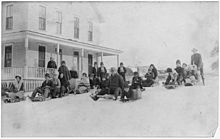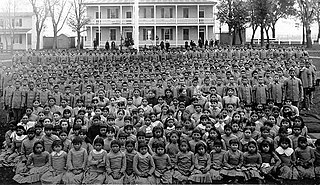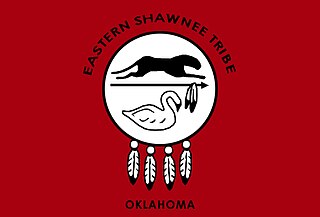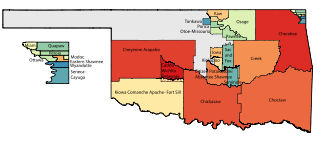
The Seneca Indian School was a Native American boarding school located in Wyandotte, Oklahoma. [1] Initially founded for Seneca, Shawnee, and Wyandotte children, in later years it had many Cherokee students. The school operated from 1872 to 1980.

The Seneca Indian School was a Native American boarding school located in Wyandotte, Oklahoma. [1] Initially founded for Seneca, Shawnee, and Wyandotte children, in later years it had many Cherokee students. The school operated from 1872 to 1980.
The Wyandotte tribe was removed to this area in 1867. The Society of Friends (Quakers) established a mission in Wyandotte in 1869. The Wyandotte Tribal Council donated land for the Quakers to establish a boarding school for Seneca, Shawnee and Wyandotte children. Construction of the school began in 1871 and classes began in 1872.
Other names for the school were Wyandotte Mission, Seneca, Shawnee, and Wyandotte Industrial Boarding School, and Seneca Boarding School. [2] By the 1920s, the composition of the student body had changed, and was largely Cherokee students.
The school had an outbreak of measles and typhoid in 1927, and "dozens of children" died. [3]
In 1928, a new principal was appointed, Joe Kagey. The school changed its admittance policy, and was opened to children of all tribes. It became an "institutional" school for children coming from situations of hardship. In 1952, there were 173 Cherokee students, and a number of students from other tribes. Kagey retired in 1956. [4] The school closed on June 15, 1980. The school's 189 acres of land were returned to the Wyandotte Tribe. [5]
A selection of school records created between 1916-1970 are held by the National Archives. [6]

Ottawa County is a county located in the northeastern corner of the U.S. state of Oklahoma. As of the 2020 census, the population was 30,285. Its county seat is Miami. The county was named for the Ottawa Tribe of Oklahoma. It is also the location of the federally recognized Modoc Nation and the Quapaw Nation, which is based in Quapaw.

Wyandotte is a town in Ottawa County, Oklahoma, United States. The population was 333 at the 2010 census, a decline of 8.26 percent from the figure of 363 recorded in 2000. The town is the tribal headquarters of the Wyandotte Nation of Oklahoma, for which the town was named. Wyandotte is part of the Joplin, Missouri metropolitan area.

The Shawnee are an Indigenous people of the Northeastern Woodlands. Their language, Shawnee is an Algonquian language.

The Wyandotte Nation is a federally recognized Native American tribe in northeastern Oklahoma. They are descendants of the Wendat Confederacy and Native Americans with territory near Georgian Bay and Lake Huron. Under pressure from Haudenosaunee and other tribes, then from European settlers and the United States government, the tribe gradually moved south and west to Michigan, Ohio, Kansas, and finally Oklahoma in the United States.

Shawnee Methodist Mission, also known as the Shawnee Mission, which later became the Shawnee Indian Manual Labor School, is located in Fairway, Kansas, United States. Designated as a National Historic Landmark in 1968, the Shawnee Methodist Mission is operated by the city as a museum. The site is owned by the Kansas Historical Society and administered as the Shawnee Indian Mission State Historic Site.

The Seneca–Cayuga Nation is one of three federally recognized tribes of Seneca people in the United States. It includes the Cayuga people and is based in Oklahoma, United States. The tribe had more than 5,000 people in 2011. They have a tribal jurisdictional area in the northeast corner of Oklahoma and are headquartered in Grove. They are descended from Iroquoian peoples who had relocated to Ohio from New York in the mid-18th century.
Sequoyah High School is a Native American boarding school serving students in grades 7 through 12, who are members of a federally recognized Native American tribe. The school is located in Park Hill, Oklahoma, with a Tahlequah post office address, and is a Bureau of Indian Education (BIE) grant school operated by the Cherokee Nation.

The Modoc Nation is a federally recognized tribe of Modoc people, located in Ottawa County in the northeast corner of Oklahoma and Modoc and Siskiyou counties in northeast California. The smallest tribe in the state, they are descendants of Captain Jack's band of Modoc people, removed in 1873 after the Modoc Wars from their traditional territory in northern California and southern Oregon. They were exiled to the Quapaw Agency in Indian Territory, where they were colocated with the Shawnee people from east of the Mississippi River.
The Quapaw Indian Agency was a territory that included parts of the present-day Oklahoma counties of Ottawa and Delaware. Established in the late 1830s as part of lands allocated to the Cherokee Nation, this area was later leased by the federal government and known as the Leased District. The area that became known as the Quapaw Agency Lands contained 220,000 acres and was located in the northeastern corner of Oklahoma where that state adjoins Missouri and Kansas.

Several Native American tribes within the United States register motor vehicles and issue license plates to those vehicles.

American Indian boarding schools, also known more recently as American Indian residential schools, were established in the United States from the mid-17th to the early 20th centuries with a primary objective of "civilizing" or assimilating Native American children and youth into European American culture. In the process, these schools denigrated Native American culture and made children give up their languages and religion. At the same time the schools provided a basic Western education. These boarding schools were first established by Christian missionaries of various denominations. The missionaries were often approved by the federal government to start both missions and schools on reservations, especially in the lightly populated areas of the West. In the late 19th and early 20th centuries especially, the government paid religious orders to provide basic education to Native American children on reservations, and later established its own schools on reservations. The Bureau of Indian Affairs (BIA) also founded additional off-reservation boarding schools based on the assimilation model. These sometimes drew children from a variety of tribes. In addition, religious orders established off-reservation schools.

The Eastern Shawnee Tribe of Oklahoma is one of three federally recognized Shawnee tribes. They are located in Oklahoma and Missouri.
Takatoka,, was the second Principal Chief of the Cherokee Nation—West (1813–1817) established in the old Arkansaw Territory.

The Cherokee Nation was a legal, autonomous, tribal government in North America recognized from 1794 to 1907. It was often referred to simply as "The Nation" by its inhabitants. The government was effectively disbanded in 1907, after its land rights had been extinguished, prior to the admission of Oklahoma as a state. During the late 20th century, the Cherokee people reorganized, instituting a government with sovereign jurisdiction known as the Cherokee Nation. On July 9, 2020, the United States Supreme Court ruled that the Muscogee (Creek) Nation had never been disestablished in the years before allotment and Oklahoma Statehood.

Oklahoma Tribal Statistical Area is a statistical entity identified and delineated by federally recognized American Indian tribes in Oklahoma as part of the U.S. Census Bureau's 2010 Census and ongoing American Community Survey. Many of these areas are also designated Tribal Jurisdictional Areas, areas within which tribes will provide government services and assert other forms of government authority. They differ from standard reservations, such as the Osage Nation of Oklahoma, in that allotment was broken up and as a consequence their residents are a mix of native and non-native people, with only tribal members subject to the tribal government. At least five of these areas, those of the so-called five civilized tribes of Cherokee, Choctaw, Chickasaw, Creek and Seminole, which cover 43% of the area of the state, are recognized as reservations by federal treaty, and thus not subject to state law or jurisdiction for tribal members.
On the eve of the American Civil War in 1861, a significant number of Indigenous peoples of the Americas had been relocated from the Southeastern United States to Indian Territory, west of the Mississippi. The inhabitants of the eastern part of the Indian Territory, the Five Civilized Tribes, were suzerain nations with established tribal governments, well established cultures, and legal systems that allowed for slavery. Before European Contact these tribes were generally matriarchial societies, with agriculture being the primary economic pursuit. The bulk of the tribes lived in towns with planned streets, residential and public areas. The people were ruled by complex hereditary chiefdoms of varying size and complexity with high levels of military organization.
Concho Indian Boarding School was a boarding school for members of the Cheyenne and Arapaho Tribes. It initially served grades 1-6, and later extended classes through grade 8. Admission was later opened to other Native American students.

Electa Quinney was a Mohican and member of the Stockbridge-Munsee Community. She founded one of the first schools in what would become Wisconsin and was the first woman to teach in a public school in the territory which would be Wisconsin.